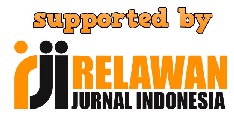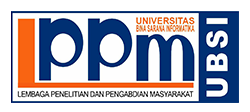Pengaruh Religiostik, EWOM, Brand Image dan Attitude terhadap Purchase Intention
Abstract
ABSTRACT
The growth of the cosmetics industry in Indonesia is very encouraging for competition between cosmetic manufacturers in Indonesia. The cosmetic competition from South Korea increases the competition to be very complex. Indonesia, which is most important for Islam, poses a different challenge for cosmetic producers so that the religiosity factor must be considered. With the spread of the internet around the world, interpersonal communication has been reshaped from traditional face-to-face communication to a more virtual way of communication called electronic word of mouth (E-WOM), where consumers have a great opportunity to share information about their consumption experiences and for investment advice on products and brands using social networking platforms and consumer review sites. This study aims to study whether religiosity, EWOM, brand image, and attitudes influence purchase intention. The research sample is the people of Batam city who see cosmetics from South Korea. The number of samples in this study was 320 respondents with a purposive sample technique. Structural Equation Modeling (SEM) based on Partial Least Square (PLS) was used in this study. The results of this study are that religiosity affects attitudes and purchase intentions, EWOM affects attitudes and purchase intentions, and attitudes that affect purchase intentions. Everything else from this study is that brand image does not affect purchase attitudes and intentions.
Keywords: religiostic, EWOM, brand image, attitude, purchase intentionKeywords
Full Text:
PDF (Bahasa Indonesia)References
Abd Rahman, A., Asrarhaghighi, E., & Ab Rahman, S. (2015). Consumers and halal cosmetic products: Knowledge, religiosity, attitude and intention. Journal of Islamic Marketing, 6(1), 148–163. https://doi.org/10.1108/JIMA-09-2013-0068
Abu-Alhaija, A. S. A., Yusof, R. N. R., Hashim, H., & Jaharuddin, N. S. (2018). Religion in consumer behaviour research: the significance of religious commitment and religious affiliation. International Journal of Economics, Commerce and Management, 6(1), 245–258.
Ahmadova, E., & Aliyev, K. (2020). Determinants of attitudes towards Halal products: Empirical evidence from Azerbaijan. Journal of Islamic Marketing. https://doi.org/10.1108/JIMA-04-2019-0068
Aji, H. M., Muslichah, I., & Seftyono, C. (2020). The determinants of Muslim travellers’ intention to visit non-Islamic countries: a halal tourism implication. Journal of Islamic Marketing. https://doi.org/10.1108/JIMA-03-2020-0075
Akın, M. S., & Okumuş, A. (2020). Shaping the consumers’ attitudes towards Halal food products in Turkey. Journal of Islamic Marketing. https://doi.org/10.1108/JIMA-08-2019-0167
Ali, A., Sherwani, M., Ali, A., Ali, Z., & Sherwani, M. (2020). Investigating the antecedents of halal brand product purchase intention: an empirical investigation. Journal of Islamic Marketing. https://doi.org/10.1108/JIMA-03-2019-0063
Amalia, F. A., Sosianika, A., & Suhartanto, D. (2020). Indonesian Millennials’ Halal food purchasing: merely a habit? British Food Journal, 122(4), 1185–1198. https://doi.org/10.1108/BFJ-10-2019-0748
Aziz, S., Md Husin, M., Hussin, N., & Afaq, Z. (2019). Factors that influence individuals’ intentions to purchase family takaful mediating role of perceived trust. Asia Pacific Journal of Marketing and Logistics, 31(1), 81–104. https://doi.org/10.1108/APJML-12-2017-0311
Bashir, A. M. (2019). Effect of halal awareness, halal logo and attitude on foreign consumers’ purchase intention. British Food Journal, 121(9), 1998–2015. https://doi.org/10.1108/BFJ-01-2019-0011
Chinomona, R. (2016). Brand communication, brand image and brand trust as antecedents of brand loyalty in Gauteng Province of South Africa. African Journal of Economic and Management Studies, VII(1). https://doi.org/10.1108/AJEMS-06-2016-0088
Doosti, S., Jalilvand, M. R., Asadi, A., Khazaei Pool, J., & Mehrani Adl, P. (2016). Analyzing the influence of electronic word of mouth on visit intention: the mediating role of tourists’ attitude and city image. International Journal of Tourism Cities, 2(2), 137–148. https://doi.org/10.1108/IJTC-12-2015-0031
Elseidi, & Al-Baz, D. (2016). Electronic word of mouth effects on consumers’ brand attitudes, brand image and purchase intention: an empirical study in Egypt. The Business and Management Review, 7(5), 514–522. https://doi.org/10.1108/02634501211231946
Elseidi, R. I., & El-baz, D. (2016). The effect of electronic word of mouth on brand image and purchase intention: An empirical study in the automobile industry in Iran. The Business and Management Review, 7(5), 514–522. https://doi.org/10.1108/02634501211231946
Fishbein, M., & Ajzen, I. (2011). Predicting and Changing Behavior.
Garg, P., & Joshi, R. (2018). Purchase intention of “Halal” brands in India: the mediating effect of attitude. Journal of Islamic Marketing, 9(3), 683–694. https://doi.org/10.1108/JIMA-11-2017-0125
Gosal, J., Andajani, E., & Rahayu, S. (2020). The Effect of e-WOM on Travel Intention, Travel Decision, City Image, and Attitude to Visit a Tourism City, 115(Insyma), 261–265. https://doi.org/10.2991/aebmr.k.200127.053
Hair, J. F., Babin, B. J., Anderson, R. E., & Black, W. C. (2018). Multivariate data analysis (8th ed.). London: Cengage Learning EMEA.
Hamouda, M., & Tabbane, R. S. (2013). Impact of Electronic Word of Mouth Evaluation on Purchase Intention : The Mediating Role of Attitude toward the Product. International Journal of Online Marketing, 3(June), 20–37. https://doi.org/10.4018/ijom.2013040102
Hanafiah, M. H., & Hamdan, N. A. A. (2020). Determinants of Muslim travellers Halal food consumption attitude and behavioural intentions. Journal of Islamic Marketing, 2. https://doi.org/10.1108/JIMA-09-2019-0195
Handriana, T., Yulianti, P., Kurniawati, M., Arina, N. A., Aisyah, R. A., Ayu Aryani, M. G., & Wandira, R. K. (2020). Purchase behavior of millennial female generation on Halal cosmetic products. Journal of Islamic Marketing. https://doi.org/10.1108/JIMA-11-2019-0235
Haque, A., Anwar, N., Tarofder, A. K., Ahmad, N. S., & Sharif, S. R. (2018). Muslim consumers’ purchase behavior towards halal cosmetic products in Malaysia. Management Science Letters, 8(12), 1305–1318. https://doi.org/10.5267/j.msl.2018.9.009
Hu, X., Ha, L. H., Mo, S., & Xu, Y. (2014). Who Are Fans of Facebook Fan Pages? an Electronic Word-of-Mouth Communication Perspective. International Journal of Cyber Society and Education, 7(2), 125–146. https://doi.org/10.7903/ijcse.1156
Indonesia. go.id. (n.d.). Agama. Retrieved from https://indonesia.go.id/profil/agama
Iranmanesh, M., Mirzaei, M., Parvin Hosseini, S. M., & Zailani, S. (2019). Muslims’ willingness to pay for certified halal food: an extension of the theory of planned behaviour. Journal of Islamic Marketing, 11(1), 14–30. https://doi.org/10.1108/JIMA-03-2018-0049
Jalilvand, M. R., Ebrahimi, A., & Samiei, N. (2013a). Electronic Word of Mouth Effects on Tourists’ Attitudes Toward Islamic Destinations and Travel Intention: An Empirical Study in Iran. Procedia - Social and Behavioral Sciences, 81(2006), 484–489. https://doi.org/10.1016/j.sbspro.2013.06.465
Jalilvand, M. R., Ebrahimi, A., & Samiei, N. (2013b). eWOM as Source of Influence: The Impact of Participation in eWOM and Perceived Source Trustworthiness on Decision Making. Procedia - Social and Behavioral Sciences, 81(2006), 484–489. https://doi.org/10.1016/j.sbspro.2013.06.465
Jalilvand, M. R., & Samiei, N. (2012). The effect of electronic word of mouth on brand image and purchase intention: An empirical study in the automobile industry in Iran. Marketing Intelligence and Planning, 30(4), 460–476. https://doi.org/10.1108/02634501211231946
Jumani, Z. A., & Sukhabot, S. (2020). Identifying the important attitude of Islamic brands and its effect on buying behavioural intentions among Malaysian Muslims: A quantitative study using smart-PLS. Journal of Islamic Marketing. https://doi.org/10.1108/JIMA-09-2019-0196
Karoui, S., & Khemakhem, R. (2019). Factors affecting the Islamic purchasing behavior – a qualitative study. Journal of Islamic Marketing, 10(4), 1104–1127. https://doi.org/10.1108/JIMA-12-2017-0145
Kemenparin. (2020). Perubahan Gaya Hidup Dorong Industri Kosmetik.
Kemenperin. (2018). Industri Kosmetik Nasional Tumbuh 20%.
Khan, Sarwar, A., & Tan, B. C. (2020). Determinants of purchase intention of halal cosmetic products among Generation Y consumers. Journal of Islamic Marketing. https://doi.org/10.1108/JIMA-11-2019-0248
Khan, W., Akhtar, A., Ansari, S. A., & Dhamija, A. (2020). Enablers of halal food purchase among Muslim consumers in an emerging economy: an interpretive structural modeling approach. British Food Journal, 122(7), 2273–2287. https://doi.org/10.1108/BFJ-08-2018-0528
Kim, S. B., & Kwon, K. J. (2018). Examining the relationships of image and attitude on visit intention to Korea among Tanzanian college students: The moderating effect of familiarity. Sustainability (Switzerland), 10(2). https://doi.org/10.3390/su10020360
Kotler, P., & Keller, K. (2009). Marketing management. Pearson Prentice Hall.
Kudeshia, C., & Kumar, A. (2017). Social eWOM: does it affect the brand attitude and purchase intention of brands? Management Research Review, 40(3), 310–330. https://doi.org/10.1108/MRR-07-2015-0161
Kumar, C. kudeshia A. (2017). Social eWOM: Does it affect the brand attitude and purchase intention of brands? Management Resesarch Review, 40(3), 39. https://doi.org/10.1108/MRR-07-2015-0161
Lin, K. Y., & Lu, H. P. (2011). Why people use social networking sites: An empirical study integrating network externalities and motivation theory. Computers in Human Behavior, 27(3), 1152–1161. https://doi.org/10.1016/j.chb.2010.12.009
López, M., & Sicilia, M. (2014). eWOM as Source of Influence: The Impact of Participation in eWOM and Perceived Source Trustworthiness on Decision Making. Journal of Interactive Advertising, 14(2), 86–97. https://doi.org/10.1080/15252019.2014.944288
Mazloomi, A., Sattari, S., & Ebrahimpour, H. (2015). Brand Loyalty , Brand Image Fitness , Final Brand Image Relationship with Attitude toward Brand at Tabarok and Delpazir Companies in Ahvaz City. Kuwait Chapter of Arabian Journal of Business and Management Review, 4(10), 11–15. https://doi.org/10.12816/0018992
Memon, Y. J., Azhar, S. M., Haque, R., & Bhutto, N. A. (2019). Religiosity as a moderator between theory of planned behavior and halal purchase intention. Journal of Islamic Marketing. https://doi.org/10.1108/JIMA-01-2019-0006
Mirabi, V., Akbariyeh, H., & Tahmasebifard, H. (2015). A Study of Factors Affecting on Customers Purchase Intention Case Study : the Agencies of Bono Brand Tile in Tehran. Journal of Multidisciplinary Engineering Science and Technology (JMEST), 2(1), 267–273.
Muflih, M., & Juliana, J. (2020). Halal-labeled food shopping behavior: the role of spirituality, image, trust, and satisfaction. Journal of Islamic Marketing. https://doi.org/10.1108/JIMA-10-2019-0200
Muhamed, A. A., Ab Rahman, M. N., Mohd Hamzah, F., Che Mohd Zain, C. R., & Zailani, S. (2019). The impact of consumption value on consumer behaviour: A case study of halal-certified food supplies. British Food Journal, 121(11), 2951–2966. https://doi.org/10.1108/BFJ-10-2018-0692
Mukhtar, A., & Butt, M. M. (2012). Intention to choose Halal products: The role of religiosity. Journal of Islamic Marketing, 3(2), 108–120. https://doi.org/10.1108/17590831211232519
Ngah, A. H., Gabarre, S., Eneizan, B., & Asri, N. (2020). Mediated and moderated model of the willingness to pay for halal transportation. Journal of Islamic Marketing. https://doi.org/10.1108/JIMA-10-2019-0199
Reza Jalilvand, M., Samiei, N., Dini, B., & Yaghoubi Manzari, P. (2012). Examining the structural relationships of electronic word of mouth, destination image, tourist attitude toward destination and travel intention: An integrated approach. Journal of Destination Marketing and Management, 1(1–2), 134–143. https://doi.org/10.1016/j.jdmm.2012.10.001
Shahid, S., Ahmed, F., & Hasan, U. (2018). A qualitative investigation into consumption of halal cosmetic products: the evidence from India. Journal of Islamic Marketing, 9(3), 484–503. https://doi.org/10.1108/JIMA-01-2017-0009
Sharma, R. R., Newaz, F. T., & Fam, K. S. (2016). Muslim religiosity, generational cohorts and buying behaviour of Islamic financial products. Australian Journal of Management, 42(3), 482–501. https://doi.org/10.1177/0312896216659530
Shukla, P. (2011). Impact of interpersonal influences, brand origin and brand image on luxury purchase intentions: Measuring interfunctional interactions and a cross-national comparison. Journal of World Business, 46(2), 242–252. https://doi.org/10.1016/j.jwb.2010.11.002
Suhartanto, D., Dean, D., Sarah, I. S., Hapsari, R., Amalia, F. A., & Suhaeni, T. (2020). Does religiosity matter for customer loyalty? Evidence from halal cosmetics. Journal of Islamic Marketing. https://doi.org/10.1108/JIMA-03-2020-0069
Suparno, C. (2020). Online purchase intention of halal cosmetics: S-O-R framework application. Journal of Islamic Marketing. https://doi.org/10.1108/JIMA-09-2019-0192
Tariq, M. I., Rafay Nawaz, M., Nawaz, M. M., & Butt, H. A. (2013). Customer Perceptions about Branding and Purchase Intention: A Study of FMCG in an Emerging Market. J. Basic. Appl. Sci. Res, 3(2), 340–347.
Tirto.id. (2017). Indonesia, Target Pasar Seksi K-Beauty di Asia.
Wibowo, M. W., Permana, D., Hanafiah, A., Ahmad, F. S., & Ting, H. (2020). Halal food credence: do the Malaysian non-Muslim consumers hesitate? Journal of Islamic Marketing. https://doi.org/10.1108/JIMA-01-2020-0013
Yunus, N. H., Ariff, M. S. M., Som, N. M., Zakuan, N., & Sulaiamn, Z. (2016). The Mediating Effect of Brand Image between Electronic Word of Mouth and Purchase Intention in Social Media. Advanced Science Letters, 22(10), 3176–3180. https://doi.org/10.1166/asl.2016.7999
ZAP, B. I. (2020). ZAP Beauty Index 2020.
Zarrad, H., & Debabi, M. (2015). Analyzing the Effect of Electronic Word of Mouth on Tourists’ attitude toward Destination and Travel Intention. International Research Journal of Social Sciences, 4(4), 2319–3565. https://doi.org/http://dx.doi.org/10.1159/000093923
Zhu, L., Li, H., Wang, F. K., He, W., & Tian, Z. (2020). How online reviews affect purchase intention: a new model based on the stimulus-organism-response (S-O-R) framework. Aslib Journal of Information Management. https://doi.org/10.1108/AJIM-11-2019-0308
DOI: https://doi.org/10.31294/jeco.v5i1.9284
Copyright (c) 2021 Lily Purwianti

This work is licensed under a Creative Commons Attribution-ShareAlike 4.0 International License.
ISSN: 2355-0295 || E-ISSN: 2549-8932
-----------------------
Indexed by:
dipublikasikan oleh LPPM Universitas Bina Sarana Informatika dengan dukungan Relawan Jurnal Indonesia
Jl. Kramat Raya No.98, Kwitang, Kec. Senen, Kota Jakarta Pusat, DKI Jakarta 10450

This work is licensed under a Creative Commons Attribution-ShareAlike 4.0 International License






